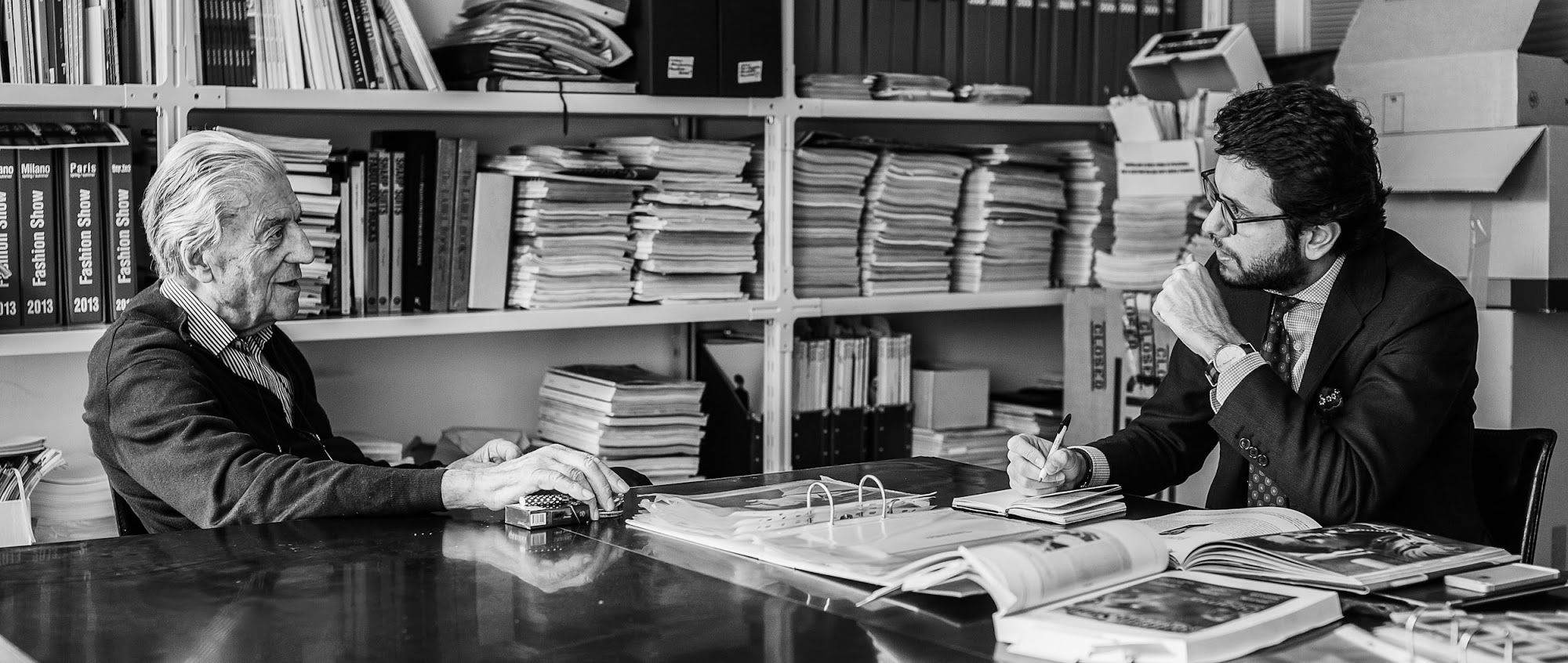“We are a populace of curious buffoons, but we are the last ones producing what makes people feel good” – Nino Cerruti
“Siamo un popolo di simpatici cialtroni, ma restiamo gli unici produttori delle cose che fanno stare bene” – Nino Cerruti
The Article - L'articolo
A brilliant, humble and passionate emperor, a tasteful gentleman who dressed Oscar-winning movie stars from Hollywood. A lot has been said about Signor Nino, as they call him in the factory, but they fail to fully capture the person that he is. Describing a man like him is a difficult task; people often say: “He created the history of fashion in Italy”. Wrong. He is the history of fashion in Italy. At only 20 he inherited his father’s factory and clients, who were initially limited to tailors. Emblematic of bygone days: “Back then, we had to limit the quantity of fabric that we could give each tailor; there were a lot of them, as they were the only source of mens clothing at the time.” – I am told in the factory.
Nostalgia of past times? No, Signor Nino reinvented himself, he created, then undid, always fixing his eye on what lay ahead. His woollen mille and his fabrics are there and every day at nine he is there. Still he wants to supervise some steps of the productive cycle, with the passion of a kid in an adult’s body and the experience of a savvy man. Listening to his words is an ensemble of mystical attraction and cinematographic marvel, without any special effect: never banal, a continuously erupting volcano, charged with brilliant ideas, a satisfied man, happily writing the script of his own life every day.
When he dressed the main characters of Hollywood movies, he never imposed his own collection, as happens today, rather, he conceived and designed the clothes for them. The aim was to assist the personality of the character and to complement it, never replacing it. What could you say to a man whose assistant for ten years has been Giorgio Armani and who has dressed men such as Alain Delon, Belmondo, Jack Nicholson, Robert Redford, including Michael Douglas e Richard Gere? Hats off and the ears wide open to learn, grow as a person and grab precious advice. Despite being eightytwo years old, Signor Nino has never lost curiosity for everything and his relationship with the cinema started in the 50’s when Anita Eckberg, after the success of La Dolce vita, decided to wear an ottanio-coloured dress, launched by Nino himself, during a celebration in Rome sponsored by Arbiter, the magazine managed by Michelangelo Testa. From that moment onward, French and American movies arrived – “a lot of actors were initially my customers at my boutique in Paris, later I dressed them for their movies”. His true consecration came with the American big screen: his name appeared in more than one hunred movies, the directors were contending him. “I made a double-breasted suit for Richard Gere in Pretty Woman, he was very tall; when the movie came out, some customers in Paris wanted to dress like him, despite being short” – he recalls while smiling and sitting aside a box reporting the sign “Tuxedo for Christian Bale”. He also mentions the clothes of Tom Hanks in Philadelphia: “The sizes of his suits gradually increased throughout the film to give spectators the impression he that he was losing weight”.
“According to you Sir, can we report a return of interest towards the made in Italy”? “More than a return to made in Italy, I would say that Italy is the only Country left that keeps a know-how in some industries” he says smiling. “We are a populace of curious buffoons, but we are the last ones producing what makes people feel good and the whole world knows it” - he adds. He loved “La grande bellezza”, finding his 60’s jackets in those of the main character Jep. And to those who accuse Sorrentino of being “too Fellinian”, he replies that the deep difference between the two movies is that in the movie by Fellini, the characters were pleasure-seekers, yet winners; in the Sorrentinian Rome they are discouraged, pathetic and weary. O tempora o mores!
As for the globalization of employement, Signor Nino is categorical: for years the importance of some crafts has not been communicated enough and now we cannot expect that the workforce is not influenced. Asian people are learning Italian productive techniques? So much better, if no Italian is willing to do it. “Preserving the art is fundamental, rather than worrying who possesses it”: in Hong Kong there is a world renowned tailor’s shop and nobody is Italian over there!”. He points out that recently the fashion industry is exaggerating, producing ugly garments in the name of a right to be comfortable, along with the right to exhibitionism. Speciality and exhibitionism are separated by a very evanescent line. Today the truth, locked in what they call fashion shows is separated from the beauty, so perfectly represented by a bespoke jacket, that is comfortable despite being very fitted.
_______________
Un brillante, umile e appassionato imperatore, un gentleman dal gusto sopraffino che ha vestito le star dei film hollywoodiani, di quelli da Oscar. Tante parole sono state spese sul Signor Nino - come lo chiamano in azienda – e non sono mai abbastanza. Arduo esprimere quel che si prova intervistando un uomo del genere; di lui sovente si dice “Ha fatto la storia della moda in Italia”. Errato. Lui è la storia della moda in Italia. A soli vent’anni eredita l’azienda paterna e i suoi clienti all’inizio erano proprio i sarti. Emblema del cambio dei tempi, “all’epoca dovevamo limitare i metraggi che davamo a ciascun sarto; erano tanti e l’uomo si vestiva solo lì”, mi dicono in azienda.
Nostalgia di tempi passati? No, il Signor Nino si è saputo reinventare, ha creato, ha disfatto, guardando sempre avanti. Il suo lanificio e i suoi tessuti sono sempre lì e lui ogni giorno alle nove è in azienda. Tutt’oggi cura personalmente alcune fasi del ciclo produttivo con la passione di un bambino in un corpo da adulto e l’esperienza di un adulto dalla vita piena. Ascoltarlo parlare è un ensemble di mistica attrazione e meraviglia cinematografica, senza bisogno di effetti speciali: mai banalità, un vulcano in continua eruzione, prodigo di idee brillanti, un uomo soddisfatto, che continua felice a scrivere ogni giorno lo script della sua vita.
Nei film hollywoodiani di cui vestiva i protagonisti, non imponeva mai le sue collezioni, come accade oggi, ma concepiva e disegnava gli abiti per loro. Lo scopo era aiutare la personalità del soggetto e completarla, senza mai rimpiazzarla. Cosa dire ad un uomo il cui assistente per dieci anni è stato Giorgio Armani, e che ha vestito da Alain Delon a Belmondo, da Jack Nicholson a Robert Redford, passando per Michael Douglas e Richard Gere? Hats off ed orecchie tese, per imparare, crescere umanamente e carpire consigli e aneddoti di vita. Con ottantadue primavere alle spalle, il signor Nino non ha perso la curiosità per tutto e racconta che il suo rapporto con il cinema inizia negli anni ‘50 quando Anita Eckberg, dopo il successo della Dolce Vita, indossa un vestito in color “ottanio”, da lui lanciato, durante una manifestazione a Roma patrocinata dalla rivista Arbiter di Michelangelo Testa. Di lì i film francesi e poi americani, “Molti attori erano clienti della mia boutique a Parigi, poi li ho vestiti nei loro film”. La consacrazione avviene con il grande schermo statunitense: più di cento i film in cui compare il suo nome, i registi se lo contendevano. “Per Richard Gere in Pretty Woman, avevo fatto degli abiti doppiopetto, era molto alto; dopo l’uscita del film, alcuni clienti a Parigi volevano vestirsi come lui, pur essendo bassi” – ricorda sorridendo, seduto di fianco ad un porta abiti con la scritta “Tuxedo for Christian Bale”. Rammenta anche gli abiti di Tom Hanks in Philadelphia: “I suoi vestiti crescevano di misura per dare l’impressione che il personaggio stesse dimagrendo”.
Secondo il Signor Nino si può parlare oggi di un ritorno di interesse verso il made in Italy? “Più che di un ritorno al made in Italy, direi che ormai è rimasta solo l’Italy capace di saper fare, in alcuni settori”, dice sorridendo. “Siamo dei simpatici cialtroni che hanno perso fiducia in loro stessi, ma restiamo gli unici produttori delle cose che fanno stare bene e questo il mondo lo sa” – aggiunge. Ha adorato La grande bellezza, ritrovando negli abiti attoliniani di Jep la bellezza delle sue giacche anni ’60. E a quei critici dicotomici che tacciano il nostro Sorrentino di essere troppo felliniano risponde che la differenza profonda tra la Grande Bellezza e la Dolce Vita sta nel fatto che nel capolavoro di Fellini i protagonisti erano dei sibariti sì, ma vincenti; nella Roma sorrentiniana sono sfiduciati, patetici e stanchi. O tempora o mores!
Quanto alla globalizzazione nel mondo del lavoro, il Signor Nino è categorico: per anni non si è comunicata l’importanza di alcuni mestieri e ora non possiamo pretendere che la globalizzazione non tocchi anche le maestranze. Ci sono asiatici che imparano le nostre tecniche produttive? Ben vengano, se non ci sono italiani disposti a farlo. “L’importante è preservare l’arte, poi è irrilevante in mano a chi sia: ad Hong Kong c’è una sartoria famosa in tutto il mondo e nessuno lì è italiano.” Sottolinea che la moda ultimamente è giunta a delle aberrazioni in nome di un diritto ad essere confortevoli, unito ad un diritto all’esibizione, ritenuto chiave necessaria per entrare in società. Specialità ed esibizionismo sono divisi da un confine molto labile. Oggi il vero, chiuso in blindate manifestazioni autoreferenziali chiamate sfilate, è separato dal bello, quella magna beltà macchiata di imperfezione, perfettamente simboleggiata da una giacca di sartoria, che pur essendo aderente, è comoda e permette i movimenti.
If you like what we are doing here, please consider following TBD on Facebook - Tumblr - Instagram - Twitter
Bespoke Hugs,
Fabio
Nino Cerruti & The Cinema
1 Aprile 2014







